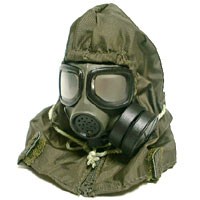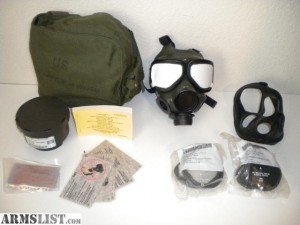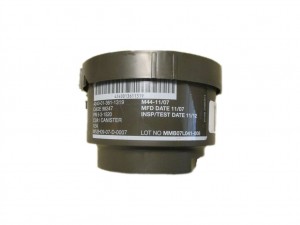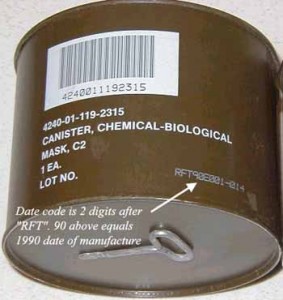First off, it’s not a gas mask; because it protects against more than just gas. But in light of recent events…Ebola and such; has made me curious about the capabilities. I visited with several coworkers that are NBC/CBRN qualified and they said our current filters would do little against biological contaminants. According to the TM, which is posted below, the M40 promask is used to:
Protect your face, eyes, and lungs from field concentrations of chemical-biological (CB) agents, toxins and radioactive fallout particles.
But it does not protect against ammonia or carbon monoxide gases. Does not protect you in closed spaces where there is not enough oxygen in the air.
But it’s still a great mask when used properly. The M40 was the result of a program in the 1980s to develop a successor to the M17-series protective masks which had been in service with the US armed forces from the 1960s. The M40 was to be a return to conventional gas mask design with an external side-mounted filter canister, rather than the internal cheek filters of the M17, which were awkward to change, especially in a contaminated environment. The final prototype, the XM40, was approved for service and then designated the M40.
The M40 was phased into service with the US Army in the mid-1990s, with another new design, the MCU-2/P similarly replacing older masks in service with the Air Force. However, both masks suffered from the inadequate protective capabilities of their facepiece, which was of a silicone rubber susceptible to corrosion from blister agents. Thus, the masks were effectively ill-suited for protecting against much more than riot control agents, and a butyl rubber ‘Second Skin’ had to be quickly issued for fitting over and reinforcing the M40 facepiece to make it effective in its intended role.
The M40 field protective mask, along with the older M17 mask, are currently being replaced by the M50 Joint Service General Purpose Mask.
But more important than the mask per se, is the capabilities of the C2A1 canister filter.
The older C2 canister on the M40 mask could protect the user from up to 15 nerve, choking, and blister agent attacks, and two blood agent attacks. The C2 filter has a black body and most have expired their shelf life. The C2A1 filter can be differentiated by its green body. The C2A1 is the current issue filter canister used by the US military. C2A1 filters can be packaged in either metal or plastic containers.
It is threaded in 40mm (specifically; It uses the Rd40 x 1/7″ thread (NATO Standard), making it compatible with most gas masks, particularly all current NATO gas masks. The modern production C2a1 filters are sealed in a plastic container to keep the filter components fresh and unexpired. The latest run of C2A1 gas mask filters are marked (ASZM-TEDA), C2A1. The (ASZM-TEDA) signifies that these canisters are manufactured with a new type of Impregnated Carbon which offers increased protection against Chemical agents. It still does not offer full protection against Ammonia-based weapons or Ammonia fumes. It probably offers some protection against these, but is not enough to protect the user against Ammonia-based agents or Ammonia fumes.
C2A1 filters can be dated using the lot number. The first number pair with letter dates the filter’s date of manufacture. MMB05A035-01, for example, indicates that the filter was manufactured in February [B] of 2005 [05]. The number cluster has been underlined for ease of reference. These filters have an official shelf life of 10 years, but unofficially some studies place the effective lifespan at somewhere around 12 years [for the more current C2A1 canisters packaged in the plastic containers, not for the older ones packaged in the metal cans].
It should be noted that the C2 and C2a1 filters used by the U.S. Military are not NIOSH approved unlike most CBRN filters manufactured today. They do however pass set standards by the US Military (MIL-C-51560 and EA-C-1704) against various chemical warfare agents.
http://gasmaskandrespirator.wikia.com/wiki/The_C2_and_C2a1_Filter_Canisters





Leave a Reply